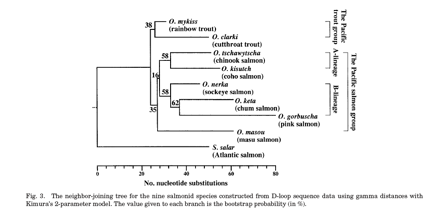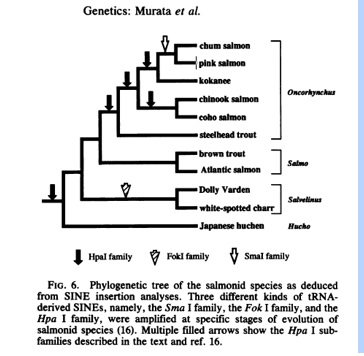Pacific Salmon Migration
Biology 342
Fall 2010Frank Sosa, Wren Kominos-Marvell
Phylogeny:
Also known as evolution, phylogeny describes the history of a given behavior in evolutionary terms, including the ancestral state and selective pressures that may have contributed to the rise of behavior.
The family Salmonidae contains a wide variety of ray-finned fish, many of which exhibit anadromous migration behavior. Salmonidae contains the genus Oncorhynchus of Pacific Salmon. It also contains the genus Salmo of the Atlantic Salmon (Salmo salar), from which the Pacific Salmon and Trout diverged. Alantic Salmon exhibit migratory behavior in which males do not necessarily die after spawning and may make repeat migrations. [9] The migration by both Atlantic Salmon and Pacific Salmon indicate that their common ancestor was migratory as well.
Due to descrepencies in the knowledge of the phylogenetic tree of Pacific Salmon it is difficult to say whether their ancient ancestors came from freshwater or ocean. Migration could have developed for freshwater fish through the value of increased food supply, or it could have developed for ocean fish through the value of coordinated mating locations.
Cause of Salmo/Oncorhynchus Divergence:
It is interesting to note that in the Atlantic Salmon/Pacific Salmon divergence there developed 5 species of Pacific Salmon while Atlantic Salmon did not speciate. The timing of the evolution in Pacific Salmon can be correlated with tectonic plate movements of the Pacific Rim. [9] This suggests that the geographical shift impacted the environments, which the Salmon migrated. Implying that the migratory behavior of Salmon in conjunction with increased topographic diversity was instrumental in the diversity of the genus Oncorhynchus. [9] This corresponds with the results of Scott A. Pavey that indicate Salmon populations can converge without a physical boundary due to migration. [10]
While this demonstrates the phylogentic order between Salmo salar and Oncorhynchus the internal order of the species within Oncorhynchus is still unconfirmed. Below are two examples of phylogenetic analysis of Oncorhynchus.
1. Using allozyme electrophoresis 13 enzymes were analyzed for 19 genetic loci corresponding to five species. When compared to nucleotide sequences of mtDNA of 9 salmonid species, the result was the following phylogenetic tree. [11]

2. Using the short interspersed element (SINE) Hpa I isolated from 12 salmonid genomes amplification of the orthologous loci of each species using PCR resulted in the following phylogenetic tree. [12]

These two phylogenetic trees show the same internal branching pattern for Oncorhynchus since Kokanee are subspecies of Sockeye Salmon and Steelhead are Rainbow trout. Other genetic phylogenetic trees differ in their categorization of Pink Salmon and Sockeye Salmon as sister species.